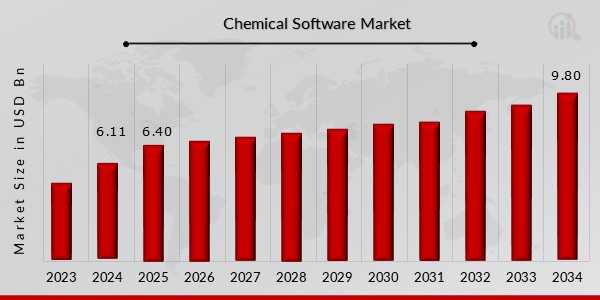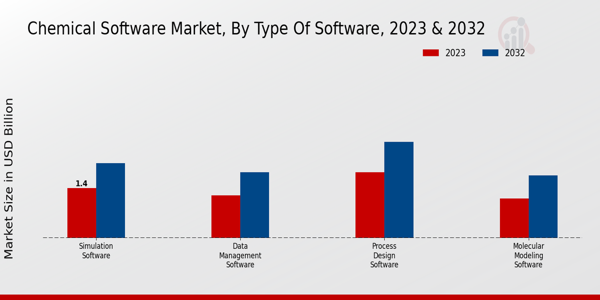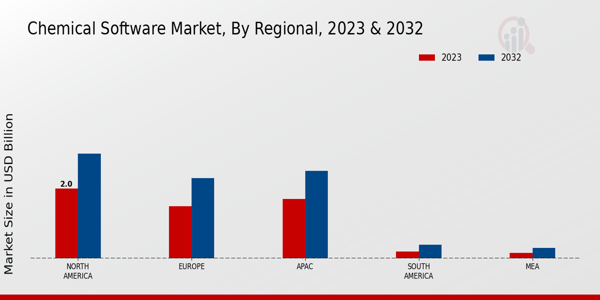Global Chemical Software Market Overview
The Chemical Software Market Size was estimated at 6.11 (USD Billion) in 2024. The Chemical Software Industry is expected to grow from 6.40(USD Billion) in 2025 to 9.80 (USD Billion) by 2034. The Chemical Software Market CAGR (growth rate) is expected to be around 4.8% during the forecast period (2025 - 2034).
Key Chemical Software Market Trends Highlighted
The Chemical Software Market is primarily driven by the increasing demand for efficiency and productivity in the chemical industry. Companies are adopting software solutions to streamline operations, reduce costs, and ensure compliance with regulations. The need for improved data management and analysis tools is also a key factor, as organizations strive to harness data for better decision-making. Moreover, the rising focus on sustainability and eco-friendly practices encourages the adoption of chemical software that supports green chemistry initiatives. There are significant opportunities in the market, particularly for software that integrates artificial intelligence and machine learning.These technologies can enhance predictive analytics, allowing companies to anticipate market changes and optimize their production processes. Additionally, there is a growing need for specialized software solutions that cater to specific sectors within the chemical industry, such as pharmaceuticals, agrochemicals, and specialty chemicals. The trend toward cloud-based solutions presents another avenue for companies to expand their offerings. In recent times, there has been a noticeable shift toward digital transformation within the chemical sector. Many organizations are investing in software that not only improves operational efficiency but also supports remote collaboration among teams.Furthermore, advancements in data analytics are shaping the future of the market as companies seek to leverage big data for insights into customer preferences and market trends. The emphasis on cybersecurity is becoming increasingly relevant, as businesses recognize the importance of protecting sensitive information. Companies are also focusing on user-friendly interfaces and customizable solutions to meet the diverse needs of their clients, which indicates a trend toward more integrated and accessible software platforms.

Source: Primary Research, Secondary Research, MRFR Database and Analyst Review
Chemical Software Market Drivers
Increasing Demand for Automation in Chemical Industries
The Chemical Software Market Industry is witnessing a notable surge in demand for automation across various chemical manufacturing sectors. Automation technologies, which include software solutions, play a pivotal role in streamlining operations, enhancing productivity, and reducing labor costs. As industries aim for higher efficiency, they are increasingly adopting specialized software that can integrate various processes, from research and development to production and supply chain management.This trend is driven by the industry's need to comply with rigorous safety standards and regulations, which often require sophisticated monitoring and control systems that chemical software can provide. Moreover, the integration of artificial intelligence (AI) and machine learning into chemical software allows for predictive analytics, which enables companies to forecast demands, optimize resource allocation, and minimize waste. The competitive landscape is also pushing companies to innovate faster, compelling them to utilize software solutions that can provide real-time insights and more agile production capabilities.Therefore, the integration of automation and advanced software solutions is set to be a significant driver for the growth of the Chemical Software Market in the coming years.
Rising Focus on Sustainability and Green Chemistry
The Chemical Software Market Industry is increasingly being driven by a growing emphasis on sustainability and green chemistry. Businesses are under pressure to reduce their environmental footprint and adapt to sustainable practices, which involves the formulation of eco-friendly chemicals and processes. Software solutions are playing an essential role in optimizing these processes to minimize environmental impact. This focus on sustainability not only meets regulatory requirements but also aligns with consumer preferences, further driving market demand.
Evolving Regulatory Compliance Requirements
The Chemical Software Market Industry is significantly influenced by the ever-evolving regulatory landscape surrounding chemical production and management. Different countries have introduced stringent regulations aimed at ensuring safety, efficiency, and environmental protection in the chemical sector. Companies are increasingly adopting chemical software to manage compliance, as these solutions provide the tools needed for monitoring, documentation, and reporting.The ability to maintain compliance with regulations can lead to cost savings and improved operational efficiencies, driving the growth of the market further.
Advancements in Research and Development
Ongoing advancements in research and development within the chemical sector are propelling the Chemical Software Market Industry forward. Companies are investing heavily in R to develop new materials and chemical processes, and software solutions are critical in this innovation journey. They provide researchers with the ability to simulate experiments, analyze vast amounts of data, and accelerate the development of new products, thereby significantly reducing time-to-market while enhancing quality.
Chemical Software Market Segment Insights
Chemical Software Market Type of Software Insights
The Chemical Software Market is projected to witness substantial growth, with a market value of 5.56 USD Billion in 2023, anticipated to climb to 8.5 USD Billion by 2032. The Type of Software segment within this market comprises several key areas including Simulation Software, Data Management Software, Process Design Software, and Molecular Modeling Software, each contributing significantly to market dynamics. Simulation Software, valued at 1.4 USD Billion in 2023 and expected to reach 2.1 USD Billion by 2032, plays a critical role in modeling chemical processes and reactions, helping businesses optimize their operations and innovate new products. Data Management Software, with an early valuation of 1.2 USD Billion in 2023 and a projected growth to 1.85 USD Billion by 2032, is essential for managing and analyzing large datasets that are typical in chemical research and development. This software ensures that data integrity is maintained while supporting enhanced decision-making processes.Process Design Software accounts for a larger share of the market, valued at 1.85 USD Billion in 2023, rising to an expected 2.7 USD Billion in 2032. This software is pivotal in streamlining the design and operation of chemical processes, making it indispensable in the industry as it directly impacts efficiency and cost reduction. Molecular Modeling Software notably holds a valuation of 1.11 USD Billion in 2023, growing to 1.75 USD Billion by 2032. This segment enables chemists and researchers to visualize molecular structures, thereby accelerating the drug discovery process and material design for various applications.
The overall segmentation of the Chemical Software Market reveals critical insights, as each type of software serves a distinct yet complementary function that drives innovation and efficiency within the chemical industry. Trends such as growing automation in chemical processes, the need for data-driven decision-making, and the increasing complexity of chemical formulations propel the adoption of these software types. Moreover, industry players face challenges such as adapting to rapid technological changes and ensuring compliance with evolving regulations, yet these challenges present opportunities for software developers to innovate and offer customized solutions. Consequently, understanding the Chemical Software Market statistics and segmentation can greatly aid stakeholders in strategically navigating this expanding market landscape.

Source: Primary Research, Secondary Research, MRFR Database and Analyst Review
Chemical Software Market Deployment Mode Insights
The Chemical Software Market is experiencing steady growth, with a projected market valuation of approximately 5.56 billion USD in 2023, expected to reach around 8.5 billion USD by 2032. Within the Deployment Mode segment, there are considerable insights regarding its structure and dynamics. On-Premises solutions are popular among organizations that prioritize control and data security, making them a significant player in the market. Cloud-Based solutions enjoy a rise in demand due to their flexibility, accessibility, and reduced maintenance costs, appealing to businesses seeking scalability in operations.The Hybrid model combines the benefits of both On-Premises and Cloud-Based systems, allowing companies to balance control with flexibility, contributing to its prominence in market growth. As the Chemical Software Market segmentations evolve, these deployment modes will likely adapt to accommodate emerging technologies and changing customer preferences, providing numerous opportunities for innovative service providers while also facing challenges related to data regulation and management. The Chemical Software Market data reflects these trends, indicating a shift towards cloud solutions driven by increasing need for operational efficiency and collaboration among teams.
Chemical Software Market End User Insights
The Chemical Software Market reached a valuation of 5.56 USD billion in 2023 and is poised for notable growth through the coming years. Within the End User segment, the importance of Chemical Manufacturers cannot be overstated, as they leverage software solutions for process optimization and compliance management. Pharmaceutical Companies increasingly depend on sophisticated chemical software for research and development, enhancing drug formulation and regulatory compliance. Academic Institutions utilize such software to foster innovation and improve curriculum around chemical engineering and research methodologies.Research Organizations are also significant contributors, using advanced software to support complex data analysis and experimental processes in their projects. The diverse applications across these entities highlight a robust demand for chemical software, reflecting a dynamic landscape where technological advancements drive efficiency, compliance, and research breakthroughs within the Chemical Software Market industry. This growth is supported by increasing regulations and the need for sustainable practices across sectors. As the market continues to expand, the diverse End User landscape positions itself as a critical factor for ongoing market analysis and investment opportunities.
Chemical Software Market Functionality Insights
The Chemical Software Market exhibits significant growth driven by its diverse functionality, with an expected valuation of 5.56 billion USD in 2023. This market is greatly influenced by various operational aspects, notably Research and Development, Production Planning, Quality Control, and Regulatory Compliance. Each area plays a crucial role in enhancing efficiency and innovation within the chemical industry. Research and Development ensures the creation of new chemical solutions, fostering innovation and competitiveness. Production Planning helps streamline processes and optimize resources, which is essential for meeting demand efficiently.Quality Control is significant as it ensures product safety and compliance with standards, directly impacting customer satisfaction. Regulatory Compliance is increasingly critical as it helps companies navigate the complex landscape of chemical regulations, ensuring adherence to laws while minimizing risks. Collectively, these functionalities represent essential pillars of the Chemical Software Market, contributing to its growth and the ability to meet industry challenges effectively. As the market evolves, the focus on these functionalities is expected to intensify, reflecting changing dynamics and demands in the chemical sector.
Chemical Software Market Regional Insights
The Chemical Software Market is segmented regionally, showcasing varying valuations across different areas. In 2023, North America stands strong with a market value of 2.0 USD Billion, indicating its dominance due to advanced technological adoption and extensive chemical industry infrastructure. Europe follows with a value of 1.5 USD Billion, where stringent regulations and emphasis on sustainability significantly drive market demand. The APAC region, valued at 1.7 USD Billion in 2023, is gaining traction as emerging economies prioritize chemical software solutions to enhance operational efficiencies.In South America, the market is relatively smaller at 0.2 USD Billion, reflecting its developing industrial landscape but with potential growth as chemical sectors expand. Meanwhile, the Middle East and Africa (MEA) represents the least dominant segment at 0.16 USD Billion in 2023, facing challenges of infrastructure and market development. However, all regions present unique opportunities for growth, guided by trends toward digitalization and increased regulatory compliance across the Chemical Software Market.

Source: Primary Research, Secondary Research, MRFR Database and Analyst Review
Chemical Software Market Key Players and Competitive Insights
The Chemical Software Market is a dynamic landscape characterized by the relentless pursuit of efficiency, safety, and regulatory compliance within the chemical industry. As organizations increasingly grapple with complex supply chains and the need for real-time data integration, the demand for robust software solutions has surged. Competitive insights in this market reflect an array of innovative software offerings designed to optimize processes such as chemical formulation, compliance management, and supply chain logistics. The landscape is populated by various players, ranging from established technology giants to niche software developers, each vying for market share by leveraging advanced technologies like artificial intelligence, cloud computing, and predictive analytics. The competition drives not only feature innovation but also the development of specialized applications tailored to unique industry needs, reinforcing the critical role that software solutions play in enhancing operational efficiency and ensuring regulatory adherence.In this marketplace, Schneider Electric stands out due to its strong presence and commitment to innovation in chemical software solutions. The company’s strengths lie in its ability to provide comprehensive platforms that integrate various aspects of chemical manufacturing and management. Schneider Electric's focus on sustainability and energy efficiency resonates with an increasingly environmentally conscious market, positioning its offerings as not only technologically adept but also aligned with sustainability goals. With extensive industry experience and a robust network, Schneider Electric has successfully built a reputation for delivering solutions that enhance operational visibility and facilitate collaboration throughout the supply chain. This solid foundation enables Schneider Electric to address a wide range of customer needs, assuring continuous improvement in productivity and compliance while minimizing risk in chemical operations.Microsoft has also made significant strides in the Chemical Software Market, leveraging its extensive technological prowess to develop solutions that cater to the unique demands of the chemical industry. The company’s cloud-based platforms, specifically designed for data management and analytics, empower businesses to harness real-time insights for more informed decision-making. Microsoft's commitment to integrating machine learning and artificial intelligence into its offerings allows users to benefit from predictive analytics, which can greatly enhance operational efficiency and reduce downtime. Additionally, Microsoft’s strong focus on collaboration and integration ensures that its software adapts well to existing systems, making it easier for companies to streamline operations without major disruptions. This adaptability, combined with Microsoft's reputation for reliability and scalability, positions them as a formidable competitor in the chemical software sector, addressing both current challenges and evolving industry trends.
Key Companies in the Chemical Software Market Include
- Schneider Electric
- Microsoft
- Honeywell
- ChemAxon
- Accenture
- Intergraph
- Worley
- Dow Chemical
- AVEVA
- Siemens
- Oracle
- Ecolab
- SAP
- Lindsay Corporation
- Aspen Technology
Chemical Software Market Industry Developments
Recent developments in the Chemical Software Market have shown significant movements. Noteworthy is the strategic partnership between Schneider Electric and Microsoft aimed at integrating their capabilities to enhance sustainability solutions for chemical manufacturing. Honeywell announced advancements in its software offerings, targeting improvements in operational efficiency for chemical processing. ChemAxon has rolled out enhancements to its chemical informatics software to better serve regulatory compliance demands. Accenture's acquisition of a tech startup focused on AI for chemical data management exemplifies the growing trend of digital transformation in the sector. Similarly, Intergraph and Worley have collaborated on new engineering software aimed at optimizing project delivery.On the financial front, Dow Chemical reported positive growth in its software solutions segment, reflecting the increasing reliance on digital tools in chemical production. Ecolab and AVEVA also noted substantial growth in their software market valuations due to heightened demand for process optimization tools in chemical industries. Notable mentions of SAP and Siemens underline the expanding influence of enterprise software in the market. Moreover, Aspen Technology's innovative software solutions have garnered attention for improving supply chain management in chemical companies, indicating a robust and evolving landscape in the Chemical Software Market.
Chemical Software Market Segmentation Insights
Chemical Software Market Type of Software Outlook
- Simulation Software
- Data Management Software
- Process Design Software
- Molecular Modeling Software
Chemical Software Market Deployment Mode Outlook
- On-Premises
- Cloud-Based
- Hybrid
Chemical Software Market End User Outlook
- Chemical Manufacturers
- Pharmaceutical Companies
- Academic Institutions
- Research Organizations
Chemical Software Market Functionality Outlook
- Research and Development
- Production Planning
- Quality Control
- Regulatory Compliance
Chemical Software Market Regional Outlook
- North America
- Europe
- South America
- Asia Pacific
- Middle East and Africa
| Report Attribute/Metric |
Details |
| Market Size 2024 |
6.11(USD Billion) |
| Market Size 2025 |
6.40(USD Billion) |
| Market Size 2034 |
9.80(USD Billion) |
| Compound Annual Growth Rate (CAGR) |
4.8% (2025 - 2034) |
| Report Coverage |
Revenue Forecast, Competitive Landscape, Growth Factors, and Trends |
| Base Year |
2024 |
| Market Forecast Period |
2025 - 2034 |
| Historical Data |
2020 - 2024 |
| Market Forecast Units |
USD Billion |
| Key Companies Profiled |
Schneider Electric, Microsoft, Honeywell, ChemAxon, Accenture, Intergraph, Worley, Dow Chemical, AVEVA, Siemens, Oracle, Ecolab, SAP, Lindsay Corporation, Aspen Technology |
| Segments Covered |
Type of Software, Deployment Mode, End User, Functionality, Regional |
| Key Market Opportunities |
Integration of AI technologies, Cloud-based software adoption, Enhanced regulatory compliance tools, Sustainability-focused software solutions, Customized chemical management platforms |
| Key Market Dynamics |
Increased automation adoption, Demand for regulatory compliance, Growth in R investments, Rising emphasis on data analytics, Shift towards cloud-based solutions |
| Countries Covered |
North America, Europe, APAC, South America, MEA |
Frequently Asked Questions (FAQ) :
The Chemical Software Market is expected to be valued at 9.80 USD Billion by 2034.
The expected CAGR for the Chemical Software Market from 2025 to 2034 is 4.8%.
North America is projected to have the largest market share, valued at 3.0 USD Billion in 2032.
The market value of Simulation Software is anticipated to reach 2.1 USD Billion by 2032.
Key players include Schneider Electric, Microsoft, Honeywell, ChemAxon, and Accenture.
Data Management Software is expected to grow from 1.2 USD Billion in 2023 to 1.85 USD Billion in 2032.
Molecular Modeling Software is expected to be valued at 1.75 USD Billion by 2032.
The APAC region is projected to grow to 2.5 USD Billion by 2032.
The estimated market value for Process Design Software is expected to be 2.7 USD Billion in 2032.
The market for Chemical Software in South America is expected to reach 0.4 USD Billion by 2032.
















